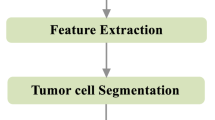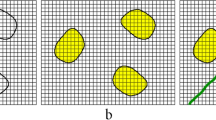Abstract
An unconstrained growth of abnormal cells in the lung causes tumors. The aim of the work is the accurate diagnoses of tumor at its early stage through hybrid segmentation algorithm. The objective of this paper is to propose a novel labeled cluster active contour method to improve the performance of automated lung tumor segmentation from 2D CT slices. To the input 2D slice, an 8-connected component analysis is implemented to differentiate the image spatial information and obtain the RGB labeled data. The tumor location is foreseen using an unsupervised k-means clustering algorithm. Then, an automated level set algorithm is carried out to appropriately localize and extract the tumor region. The amount of initial level set curve evolution is controlled by the clustering efficiency of k-Means and labeling efficacy of connected component analysis. The quantitative evaluation of segmentation is carried out based on Shape features like area, perimeter, eccentricity, convex area, solidity, and roundness. The statistical object-based and distance-based metrics were used to find the similarity between manual and proposed methods. Also, performance metrics like accuracy, specificity, sensitivity, precision, and recall are used to validate the segmentation results of the proposed method. The proposed system is evaluated over 42 datasets from the commonly available large dataset LIDC (Lung Image Database Consortium). The accuracy, specificity, sensitivity and precision of the proposed hybrid method are 97.5%, 97.43%, 91.67%, and 98.79%, which exhibited the best competence as compared to traditional methods on the same dataset. The statistical and quantitative analysis shows the efficiency of the present work.










Similar content being viewed by others
References
Abdel-Maksoud E, Elmogy M, Al-Awadic R (2015) Brain tumor segmentation based on a hybrid clustering technique. Egypt Inform J 16(1):71–81
Albert C, Stefano A, Russo G, Bignardi S, Sabini MG, Petrucci G, Ippolito M, Yezzi A (2019) K-nearest neighbor driving active contours to delineate biological tumor volumes. Eng Appl Artif Intell 1(81):133–144
Andreas K, Moltz JH, Bornemann L, Kuhnigk J-M, Dicken V, Peitgen E, Meier S, Bolte H, Fabel M, Bauknecht H-C, Hittinger M, Püsken M, Peitgen H-O (2009) Advanced segmentation techniques for lung nodules, liver metastases, and enlarged lymph nodes in CT Scans. IEEE J Select Top Signal Process 3(1):122–134
Anter AM, Hassanien AE, Soud MAE, Azar AT (2015) Automatic liver parenchyma segmentation system from abdominal CT scans using hybrid techniques. Int J Biomed Eng Technol 17(2):148–167
Awais M, Bagci U, Foster B, Ziyue Xu, Papadakis GZ, Folio LR, Mollura DJ (2015) Segmentation and image analysis of abnormal lungs at CT: current approaches, challenges, and future trends. Radio Graph 35(4):1056–1076
Badura P, Pietka E (2014) Soft computing approach to 3D lung nodule segmentation in CT. Comput Biol Med 53:230–243
Chen W, Wei H, Peng S, Sun J, Qiao X, Liu B (2019) HSN: hybrid segmentation network for small cell lung cancer segmentation. IEEE Access 6(7):75591–75603
Chong Z, Shen X, Cheng H, Qian Q (2019) Brain tumor segmentation based on hybrid clustering and morphological operations. Int J Biomed Imaging 2019:1–12
Chung FJK, Huang CC, Siao JJ, Hsieh CW, Huy VQ, Ko KH, Hsu HH (2020) Automatic lung nodule detection system using image processing techniques in computed tomography. Biomed Signal Process Control 1(56):101659–101679
Ezhil EN, Kumar SS (2015) Segmentation of lung nodule in CT data using active contour model and Fuzzy C-mean clustering. Alex Eng J 55:2583–2588
Gu Y, Lu X, Yang L, Zhang B, Yu D, Zhao Y, Gao L, Wu L, Zhou T (2018) Automatic lung nodule detection using a 3D deep convolutional neural network combined with a multi-scale prediction strategy in chest CTs. Comput Biol Med 1(103):220–231
Jayashree KC, Zha DB et al (2016) A comparison of lung nodule segmentation algorithms: methods and results from a multi-institutional study. J Digit Imaging 29:476–487
Kaviarasu K, Sakthivel V (2016) K-means clustering using Fuzzy C-means based image segmentation for lung cancer. S Asian J Eng Technol 2(17):10–17
Le TK (2013) Segmentation of lung vessels together with nodules in ct images using morphological operations and level set method. J Med Bioeng 2(1):1–10
Li BN, Chui CK, Chang S, Ong SH (2011) Integrating spatial fuzzy clustering with level set methods for automated medical image segmentation. Comput Biol Med 41(1):1–10
Li-Feng H, Member S, Chao Y-Y, Suzuki K (2013) An algorithm for connected-component labeling, hole labeling and euler number computing. J Comput Sci Technol 28(3):468–478
Mamta DK, Akarte SP (2013) Brain image segmentation algorithm using K-means clustering. Int J Comput Sci Appl 5(3):1521–1524
Maya E, Korah R, Geetha G (2016) Computerized liver segmentation from ct images using probabilistic level set approach. Arab J Sci Eng 41(3):921–934
Priyanshu T, Tyagi S, Nath M (2019) A comparative analysis of segmentation techniques for lung cancer detection. Pattern Recogn Image Anal 29:167–173
Qiao W, Hu Y, Gelfand G, MacGregor JH (2009) Segmentation of lung lobes in high-resolution isotropic CT images. IEEE Trans Biomed Eng 56(5):1383–1393
Reeves AP, Chan AB, Yankelevitz DF, Henschke CI, Kressler B, Kostis WJ (2015) On measuring the change in size of pulmonary nodules. IEEE Trans Med Imaging 25(4):435–450
Rikxoort EM, de Hoop B, Viergever MA, Prokop M, van Ginneken B (2009) Automatic lung segmentation from thoracic computed tomography scans using a hybrid approach with error detection. Med Phys 36(7):2934–2947
Samuel GA, Li F, Giger ML, MacMahon H, Sone S, Doi K (2002) Performance of automated lung nodule detection method. Radiology 225(3):685–692
Stefano D, Member IEEE, Picozzi G, Falchini M, Mascalchi M, Villari N, Valli G (2008) 3-D Segmentation algorithm of small lung nodules in spiral CT images. IEEE Trans Inf Technol Biomed 12(1):7–19
Sudharshan DP (2015) A fast and robust level set method for medical image segmentation. Int J Appl Eng Res 10(11):28645–28655
Vyavahare AJ (2014) Connected component based medical image segmentation. Int J Innov Res Electr Electron Instrum Control Eng 2(8):1808–1812
Xue QY, Hughes S, Wade S, Caruana M, Canfell K, O'Connell DL (2019) Statistical projection methods for lung cancer incidence and mortality: a systematic review. BMJ Open 9(8):1–17
Yongqiang T, Schwartz LH, Zhao B (2013) Segmentation of lung lesions on CT scans using watershed, active contours, and Markov random field. Med Phys 40(4):043502–43510
Author information
Authors and Affiliations
Corresponding author
Additional information
Publisher's Note
Springer Nature remains neutral with regard to jurisdictional claims in published maps and institutional affiliations.
Rights and permissions
About this article
Cite this article
Devi, K.Y., Sasikala, M. Labeling and clustering-based level set method for automated segmentation of lung tumor stages in CT images. J Ambient Intell Human Comput 12, 2299–2309 (2021). https://doi.org/10.1007/s12652-020-02329-9
Received:
Accepted:
Published:
Issue Date:
DOI: https://doi.org/10.1007/s12652-020-02329-9




